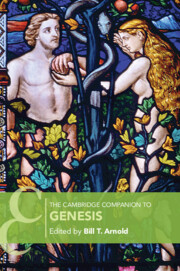Book contents
- The Cambridge Companion to Genesis
- Cambridge Companions to Religion
- The Cambridge Companion to Genesis
- Copyright page
- Contents
- Abbreviations
- Contributors
- 1 Introduction: Genesis and the status quaestionis
- Part I Composition and Structure of Genesis
- Part II Social World of Genesis
- 6 Genesis and Its Ancient Literary Analogues
- 7 Genesis and the Conceptual World of the Ancient Near East
- 8 Family, Clan, and Tribe in the Book of Genesis
- 9 Women’s Status and Feminist Readings of Genesis
- Part III Themes and Literary Motifs of Genesis
- Part IV Reception History of Genesis
- Scripture Index
- Subject Index
- Cambridge Companions to Religion (continued from page iii)
- References
6 - Genesis and Its Ancient Literary Analogues
from Part II - Social World of Genesis
Published online by Cambridge University Press: 02 June 2022
- The Cambridge Companion to Genesis
- Cambridge Companions to Religion
- The Cambridge Companion to Genesis
- Copyright page
- Contents
- Abbreviations
- Contributors
- 1 Introduction: Genesis and the status quaestionis
- Part I Composition and Structure of Genesis
- Part II Social World of Genesis
- 6 Genesis and Its Ancient Literary Analogues
- 7 Genesis and the Conceptual World of the Ancient Near East
- 8 Family, Clan, and Tribe in the Book of Genesis
- 9 Women’s Status and Feminist Readings of Genesis
- Part III Themes and Literary Motifs of Genesis
- Part IV Reception History of Genesis
- Scripture Index
- Subject Index
- Cambridge Companions to Religion (continued from page iii)
- References
Summary
The book of Genesis stands apart from the rest of the Hebrew Bible in the diverse genres and topics that it covers, from creation accounts to shorter etiologies (e.g., the advent of clothing [Gen 3:7, 21], animal husbandry, agriculture, arts and crafts [Gen 4], dietary laws [Gen 9:3–4], the diversification of language [Gen 11:1–9]), and the early histories of specific linguistic and cultural groups descended from Noah’s three sons, Shem, Ham, and Japhet. Genesis 12–50, which focuses on Shem’s descendants, introduces key figures referred to here as the ancestors: Abraham/Sarah, Isaac/Rebecca, Jacob (renamed Israel)/Leah and Rachel (his two principal wives), and the twelve fathers of the tribes of Israel, Jacob’s male offspring.
- Type
- Chapter
- Information
- The Cambridge Companion to Genesis , pp. 121 - 147Publisher: Cambridge University PressPrint publication year: 2022



